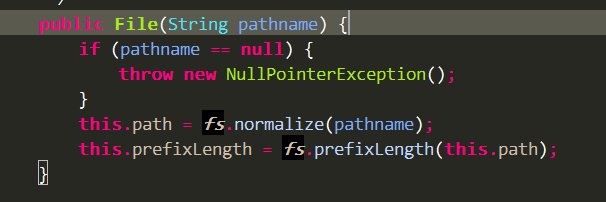java File源碼理解,探索File路徑
1.方法: new File(path);
我们知道根据输入的路径path的不同 ,File可以根据path的不同格式,来访问文件。那么,path的形式有几种呢?
根据源码



可以看出,我们是从WinNTFileSystem 的resolve得到绝对路径
@Override
public String resolve(File f) {
String path = f.getPath();
int pl = f.getPrefixLength();
if ((pl == 2) && (path.charAt(0) == slash))
return path; /* UNC */
if (pl == 3)
return path; /* Absolute local */
if (pl == 0)
return getUserPath() + slashify(path); /* Completely relative */
if (pl == 1) { /* Drive-relative */
String up = getUserPath();
String ud = getDrive(up);
if (ud != null) return ud + path;
return up + path; /* User dir is a UNC path */
}
if (pl == 2) { /* Directory-relative */
String up = getUserPath();
String ud = getDrive(up);
if ((ud != null) && path.startsWith(ud))
return up + slashify(path.substring(2));
char drive = path.charAt(0);
String dir = getDriveDirectory(drive);
String np;
if (dir != null) {
/* When resolving a directory-relative path that refers to a
drive other than the current drive, insist that the caller
have read permission on the result */
String p = drive + (':' + dir + slashify(path.substring(2)));
SecurityManager security = System.getSecurityManager();
try {
if (security != null) security.checkRead(p);
} catch (SecurityException x) {
/* Don't disclose the drive's directory in the exception */
throw new SecurityException("Cannot resolve path " + path);
}
return p;
}
return drive + ":" + slashify(path.substring(2)); /* fake it */
}
throw new InternalError("Unresolvable path: " + path);
}登入後複製
我们需要两个参数,即String path = f.getPath();和int pl = f.getPrefixLength();
得到path
注意:windows 把"\\"当成"\"处理,即 "\\".length() ==1
@Override
public String normalize(String path) {
int n = path.length();
char slash = this.slash;
char altSlash = this.altSlash;
char prev = 0;
for (int i = 0; i < n; i++) {
char c = path.charAt(i);
if (c == altSlash) // 1:包含“/”
return normalize(path, n, (prev == slash) ? i - 1 : i);
if ((c == slash) && (prev == slash) && (i > 1)) /:2:包含 "\",并且"\\",并且i>1
return normalize(path, n, i - 1);
if ((c == ':') && (i > 1)) //3:包含 ":",并且i>1
return normalize(path, n, 0);
prev = c;
}
if (prev == slash) return normalize(path, n, n - 1);
return path; //4:若是绝对路径,则直接返回绝对路径
//5:"\\" 或 "\" 开头,直接返回
}登入後複製
/* Normalize the given pathname, whose length is len, starting at the given
offset; everything before this offset is already normal. */
private String normalize(String path, int len, int off) {
if (len == 0) return path;
if (off < 3) off = 0; /* Avoid fencepost cases with UNC pathnames */
int src;
char slash = this.slash;
StringBuffer sb = new StringBuffer(len);
if (off == 0) {
/* Complete normalization, including prefix */
src = normalizePrefix(path, len, sb);
} else {
/* Partial normalization */
src = off;
sb.append(path.substring(0, off));
}
/* Remove redundant slashes from the remainder of the path, forcing all
slashes into the preferred slash */
while (src < len) {
char c = path.charAt(src++);
if (isSlash(c)) {
while ((src < len) && isSlash(path.charAt(src))) src++;
if (src == len) {
/* Check for trailing separator */
int sn = sb.length();
if ((sn == 2) && (sb.charAt(1) == ':')) {
/* "z:\\" */
sb.append(slash);
break;
}
if (sn == 0) {
/* "\\" */
sb.append(slash);
break;
}
if ((sn == 1) && (isSlash(sb.charAt(0)))) {
/* "\\\\" is not collapsed to "\\" because "\\\\" marks
the beginning of a UNC pathname. Even though it is
not, by itself, a valid UNC pathname, we leave it as
is in order to be consistent with the win32 APIs,
which treat this case as an invalid UNC pathname
rather than as an alias for the root directory of
the current drive. */
sb.append(slash);
break;
}
/* Path does not denote a root directory, so do not append
trailing slash */
break;
} else {
sb.append(slash);
}
} else {
sb.append(c);
}
}
String rv = sb.toString();
return rv;
}登入後複製
路径类型的分类:
@Override
public int prefixLength(String path) {
char slash = this.slash;
int n = path.length();
if (n == 0) return 0;
char c0 = path.charAt(0);
char c1 = (n > 1) ? path.charAt(1) : 0;
if (c0 == slash) {
if (c1 == slash) return 2; /* Absolute UNC pathname "\\\\foo" */ UNC的绝对路径
return 1; /* Drive-relative "\\foo" */ 与驱动盘相对路径
}
if (isLetter(c0) && (c1 == ':')) {
if ((n > 2) && (path.charAt(2) == slash))
return 3; /* Absolute local pathname "z:\\foo" */ 本地绝对路径
return 2; /* Directory-relative "z:foo" */ 目录相对路径
}
return 0; /* Completely relative */ 相对路径
}登入後複製
File(path)各种输入的path 及其 绝对路径

总结: 1:输入path 以'/' 或者 ’\\‘ 开头的 ,是以项目所在的硬盘位基础路径
2:输入path 以 字母开头 的,是以项目的路径为基础路径 即: System.getProperty("user.dir")
3.输入绝对路径的,就是以该绝对路径做为路径咯
本網站聲明
本文內容由網友自願投稿,版權歸原作者所有。本站不承擔相應的法律責任。如發現涉嫌抄襲或侵權的內容,請聯絡admin@php.cn

熱AI工具

Undresser.AI Undress
人工智慧驅動的應用程序,用於創建逼真的裸體照片

AI Clothes Remover
用於從照片中去除衣服的線上人工智慧工具。

Undress AI Tool
免費脫衣圖片

Clothoff.io
AI脫衣器

Video Face Swap
使用我們完全免費的人工智慧換臉工具,輕鬆在任何影片中換臉!

熱門文章
Windows 11 KB5054979中的新功能以及如何解決更新問題
3 週前
By DDD
如何修復KB5055523無法在Windows 11中安裝?
3 週前
By DDD
Inzoi:如何申請學校和大學
4 週前
By DDD
如何修復KB5055518無法在Windows 10中安裝?
3 週前
By DDD
在哪裡可以找到Atomfall中的站點辦公室鑰匙
4 週前
By DDD

熱工具

記事本++7.3.1
好用且免費的程式碼編輯器

SublimeText3漢化版
中文版,非常好用

禪工作室 13.0.1
強大的PHP整合開發環境

Dreamweaver CS6
視覺化網頁開發工具

SublimeText3 Mac版
神級程式碼編輯軟體(SublimeText3)




